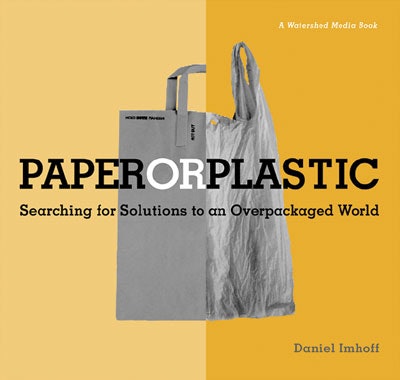
Paper or Plastic: Searching for Solutions to an Overpackaged World
Author: Daniel Imhoff
Publisher: Seirra Club Books
Specifications:
Pages: 168
Paperback
Price: $16.95
Though the book did indeed start out as a polemic indicting packaging for many injustices against the earth, it quickly changed into a more productive—and provocative—course. As such, I came out of editorial retirement to hammer out this book review, which the editors of Packaging World have graciously agreed to publish.
Imhoff rightly targets the true guilty party, and it’s not the packagers or their suppliers. It’s we consumers, and our on-the-go, single-use, disposable lifestyle. But the book goes far beyond assigning blame. Its theme is searching for solutions, and that it does.
Imhoff acknowledges that there is no silver bullet, and that trade-offs prevail no matter what the material or package. Even the concept of life-cycle analysis (LCA), which purports to measure the cradle-to-grave impact of a package, is not so cut and dried, Imhoff argues. He says that LCAs are typically too complex to be useful and do not capture the complexities of today’s global production and recovery systems. “Most experts agree that no LCA can ever fully account for all the complex factors that make up even a single material,” he writes. “Almost by default, LCAs serve only as incomplete portraits of a complete production system.”
Imhoff identifies the major obstacles preventing packaging reform: lack of corporate leadership, marketing-driven design priorities, lack of worldwide and intra-industry standardization, disconnects between product and package longevity, consumerism and citizen apathy, global capitalism, to name just a few.
He then goes on to deliver ideas that will encourage new directions in thinking for designers and materials specifiers. Sprinkled throughout are numerous informative, succinct case studies of enviro-packaging done right—by packagers, by suppliers, or even by whole nations. Imhoff reports on what is realistically possible in terms of the latest technology—from a new generation of zero-effluent mini-mills to the latest thinking in natural capitalism, eco-intelligence, cradle-to-cradle design, and biomimicry, all as applied to packaging. (The biomimicry section alone should spur many ideas.) Imhoff also covers the newest generation of bioplastics from a variety of suppliers, reviewing pros and cons of each material.
Also included: a comprehensive checklist for assessing the environmental impact of packaging before the designer makes a selection decision, including attributes that designers should keep in mind when selecting materials for a package. The book is rounded out with a comprehensive list of resources, including a handy list (by no means exhaustive) of packaging suppliers who offer green packaging. Imhoff also includes a gallery, complete with photographs, of actual packages and packaging systems that embody the latest thinking in environmentally advanced packaging.
Whether you agree or disagree with this book’s contents, put it on your bookshelf either way, especially if you are a designer or materials specifier. Too often, in our rush to build the ultimate package that satisfies the consumer and the retailer, we forget about how even the most minor package design decisions can impact our world. This book reminds us of that, while giving us plenty of new fodder to innovate in an area that arguably needs it the most.

























